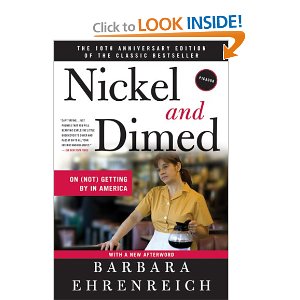 With the Fiscal Cliff1 looming, kids, it’s time for “The Talk.”
With the Fiscal Cliff1 looming, kids, it’s time for “The Talk.”
By ‘The Talk,’ I mean yank our minds into the grown-up world. We have been innocent about how money really gets made, and kept, and taxed. The ‘adults’ know, but they haven’t felt comfortable sharing the real truth. We didn’t know, and we didn’t think we could talk about it. It seems embarrassing for some reason. Almost dirty. Maybe it’s the way we were brought up. Nevertheless, now’s the time for ‘The Talk.’
Here it is in a nutshell: The way the ‘grown-ups’ – our elected officials – set tax policy tells us how they value different ways of making money. They see three different ways to make money, and they clearly favor the first two.
Inherited Money
According to our tax code it turns out the very best way to make money is the old-fashioned way: Inherit it.
As of this writing, the first $5 million from a deceased individual can pass to you tax free. Our elected leaders want you to know that the best way to get rich is to be born into a rich family and have the right people die at the right time.2
Stated that way, it seems a bit un-American, no? A bit, well, aristocratic. Nevertheless, that’s far and away the best way to earn your first $5 million. Our leaders want you, Richie Rich, to have your first $5 million tax free.3 Mwah!
Make money with your money
The second best way to get wealthy, according to the tax code, is to already have a lot of money, and then earn money on your money.
If you already have a lot of money, then a significant proportion, probably a majority of your income, will come from three sources: Tax Free Bonds, long-term capital gains on your investments, or corporate stock dividends.4
The best of these investments, tax wise, is Triple Tax Free municipal bonds, which are exempt from local, state and federal income taxes. You earn just about 0.5% interest5 these days, but if you’ve got $100 million in triple tax free muni bonds then you’ve got yourself $500,000 a year, tax free! That pays for quite a few golf outings a year, with money left over for the lobster roll at the club and a tip for the valet.
The next best way to make a living from your investments, according to the tax code, is to buy and hold stocks for at least 18 months before selling at a profit, so that your earnings will be taxed at a rate of only 15%, the long-term capital gains rate.
Should you be so fortunate as to start out in life with a massive stock portfolio, your elected officials say to you: “Good Job! That’s an excellent way to make a living! Let us incentivize you to earn the majority of your living by having your pile of money do all the work, while you join that swell municipal bond fellow at the club.”
The third best way to earn money from your money is to hold stocks for at least 60 days, thereby earning qualified dividends, likewise taxed at a comfortable 15% rate.6
I interpret all of these three tax policies combined as our elected officials’ way of saying that the next best way of making a living – after being born into a rich family – is to sit around like Scrooge McDuck investing money, and only paying 0% and 15% on one’s income.7
Mitt Romney’s 14% effective tax rate in 2011 derives from this tax advantaged way to ‘earn’ a living, just as your elected officials would like you to.
Working for a living
The ‘grown-ups’ who make tax policy tell us this is the worst way to make money. You see, if you work for a salary, that income is liable to be taxed at the maximum income tax rate.
If you can make less than $35,350 a year, fine, they’ll tax you at a 15% rate.
But over that, you’re looking at 25%, 28%, 33%, or up to 35% for those making over $388,351. The lesson of the tax code is that people who actually work for a living, rather than inherit from Daddy or live like Scrooge McDuck, should be taxed the most. “Working for a living?” they taunt us, “that’s for chumps! Tax that man at the maximum possible rate!”
 That’s “The Talk” about our tax policy which creates better and worse ways to make money in this country. No, Virginia, there is no Santa Claus, but there is a Richie Rich and a Scrooge McDuck. And our elected officials just love them!
That’s “The Talk” about our tax policy which creates better and worse ways to make money in this country. No, Virginia, there is no Santa Claus, but there is a Richie Rich and a Scrooge McDuck. And our elected officials just love them!
Post read (9769) times.
- Is it weird that I love the sound that the phrase ‘Fiscal Cliff’ makes in the mouth? Its poetry, really. To mangle a bit of Nabokov: “Fis.Cal.Cliff. Taking a trip of three steps through the split fricative to tap front teeth, at three, on the lower lip.” ↩
- Yankees owner and billionaire George Steinbrenner famously died in 2010, the one year in recent memory during which the Estate Tax was wholly repealed. George was worth an estimate $1.1 Billion, so the fact of the Estate Tax repeal in 2010 made the Steinbrenner heirs $500 million richer than they would have been had he died in 2009, as the estate tax rate was 45% of inherited wealth that year. As a Red Sox fan, I’m just so happy for those boys, Hal and Hank. It couldn’t have happened to a nicer family. ↩
- We will hear, or we should hear, quite a bit about the estate tax in the coming weeks, as the limit exemption on tax-free inheritance reverts back to $1 million and a 55% rate in 2013, if Congress does not take action. “Death Taxes on Small Businesses” is how one political side always describes the Estate Tax, but that’s mostly a load of bull. The real implication of the estate tax is to what extent our leaders signal that the best way to get $5 million is to be born into the right family. ↩
- If you’re not making any money through tax free munis, long term stock holdings and dividends, well then you can just skip to the third section, you working stiff. Our elected officials can’t be bothered with you, if you can’t take a hint about how to make money. Jeez. ↩
- On 5 year municipal bonds, for example. ↩
- The low 15% ‘qualified dividends’ tax incentive ends in 2012, unless Congress acts to extend or modify it, as Congress did, with Obama’s approval, in 2010. ↩
- The other great advantage to being Scrooge McDuck from a tax perspective, is that – unlike a working-stiff salaryman – you can choose what year to harvest stock market gains. Scrooge McDuck can end up with virtually no taxable income in any given year should he choose to sell no appreciated stock. Or Mr. Duck can match up investment losses with investment gains to have no net taxable income, or even to trigger a tax refund. In a related story, did you know Mitt Romney got a $1.6 million tax refund last year? ↩


